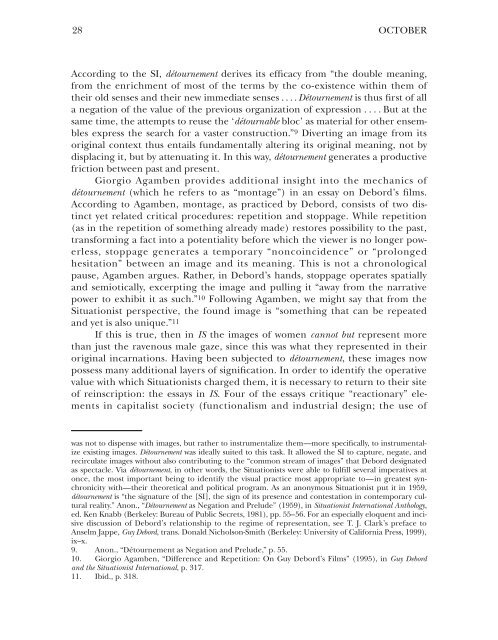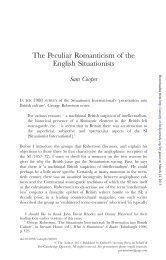The Sex of the Situationist International* - 1000 Little Hammers
The Sex of the Situationist International* - 1000 Little Hammers
The Sex of the Situationist International* - 1000 Little Hammers
You also want an ePaper? Increase the reach of your titles
YUMPU automatically turns print PDFs into web optimized ePapers that Google loves.
28<br />
OCTOBER<br />
According to <strong>the</strong> SI, détournement derives its efficacy from “<strong>the</strong> double meaning,<br />
from <strong>the</strong> enrichment <strong>of</strong> most <strong>of</strong> <strong>the</strong> terms by <strong>the</strong> co-existence within <strong>the</strong>m <strong>of</strong><br />
<strong>the</strong>ir old senses and <strong>the</strong>ir new immediate senses . . . . Détournement is thus first <strong>of</strong> all<br />
a negation <strong>of</strong> <strong>the</strong> value <strong>of</strong> <strong>the</strong> previous organization <strong>of</strong> expression . . . . But at <strong>the</strong><br />
same time, <strong>the</strong> attempts to reuse <strong>the</strong> ‘détournable bloc’ as material for o<strong>the</strong>r ensembles<br />
express <strong>the</strong> search for a vaster construction.” 9 Diverting an image from its<br />
original context thus entails fundamentally altering its original meaning, not by<br />
displacing it, but by attenuating it. In this way, détournement generates a productive<br />
friction between past and present.<br />
Giorgio Agamben provides additional insight into <strong>the</strong> mechanics <strong>of</strong><br />
détournement (which he refers to as “montage”) in an essay on Debord’s films.<br />
According to Agamben, montage, as practiced by Debord, consists <strong>of</strong> two distinct<br />
yet related critical procedures: repetition and stoppage. While repetition<br />
(as in <strong>the</strong> repetition <strong>of</strong> something already made) restores possibility to <strong>the</strong> past,<br />
transforming a fact into a potentiality before which <strong>the</strong> viewer is no longer powerless,<br />
stoppage generates a temporary “noncoincidence” or “prolonged<br />
hesitation” between an image and its meaning. This is not a chronological<br />
pause, Agamben argues. Ra<strong>the</strong>r, in Debord’s hands, stoppage operates spatially<br />
and semiotically, excerpting <strong>the</strong> image and pulling it “away from <strong>the</strong> narrative<br />
power to exhibit it as such.” 10 Following Agamben, we might say that from <strong>the</strong><br />
<strong>Situationist</strong> perspective, <strong>the</strong> found image is “something that can be repeated<br />
and yet is also unique.” 11<br />
If this is true, <strong>the</strong>n in IS <strong>the</strong> images <strong>of</strong> women cannot but represent more<br />
than just <strong>the</strong> ravenous male gaze, since this was what <strong>the</strong>y represented in <strong>the</strong>ir<br />
original incarnations. Having been subjected to détournement, <strong>the</strong>se images now<br />
possess many additional layers <strong>of</strong> signification. In order to identify <strong>the</strong> operative<br />
value with which <strong>Situationist</strong>s charged <strong>the</strong>m, it is necessary to return to <strong>the</strong>ir site<br />
<strong>of</strong> reinscription: <strong>the</strong> essays in IS. Four <strong>of</strong> <strong>the</strong> essays critique “reactionary” elements<br />
in capitalist society (functionalism and industrial design; <strong>the</strong> use <strong>of</strong><br />
was not to dispense with images, but ra<strong>the</strong>r to instrumentalize <strong>the</strong>m—more specifically, to instrumentalize<br />
existing images. Détournement was ideally suited to this task. It allowed <strong>the</strong> SI to capture, negate, and<br />
recirculate images without also contributing to <strong>the</strong> “common stream <strong>of</strong> images” that Debord designated<br />
as spectacle. Via détournement, in o<strong>the</strong>r words, <strong>the</strong> <strong>Situationist</strong>s were able to fulfill several imperatives at<br />
once, <strong>the</strong> most important being to identify <strong>the</strong> visual practice most appropriate to—in greatest synchronicity<br />
with—<strong>the</strong>ir <strong>the</strong>oretical and political program. As an anonymous <strong>Situationist</strong> put it in 1959,<br />
détournement is “<strong>the</strong> signature <strong>of</strong> <strong>the</strong> [SI], <strong>the</strong> sign <strong>of</strong> its presence and contestation in contemporary cultural<br />
reality.” Anon., “Détournement as Negation and Prelude” (1959), in <strong>Situationist</strong> International Anthology,<br />
ed. Ken Knabb (Berkeley: Bureau <strong>of</strong> Public Secrets, 1981), pp. 55–56. For an especially eloquent and incisive<br />
discussion <strong>of</strong> Debord’s relationship to <strong>the</strong> regime <strong>of</strong> representation, see T. J. Clark’s preface to<br />
Anselm Jappe, Guy Debord, trans. Donald Nicholson-Smith (Berkeley: University <strong>of</strong> California Press, 1999),<br />
ix–x.<br />
9. Anon., “Détournement as Negation and Prelude,” p. 55.<br />
10. Giorgio Agamben, “Difference and Repetition: On Guy Debord’s Films” (1995), in Guy Debord<br />
and <strong>the</strong> <strong>Situationist</strong> International, p. 317.<br />
11. Ibid., p. 318.



